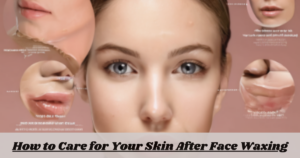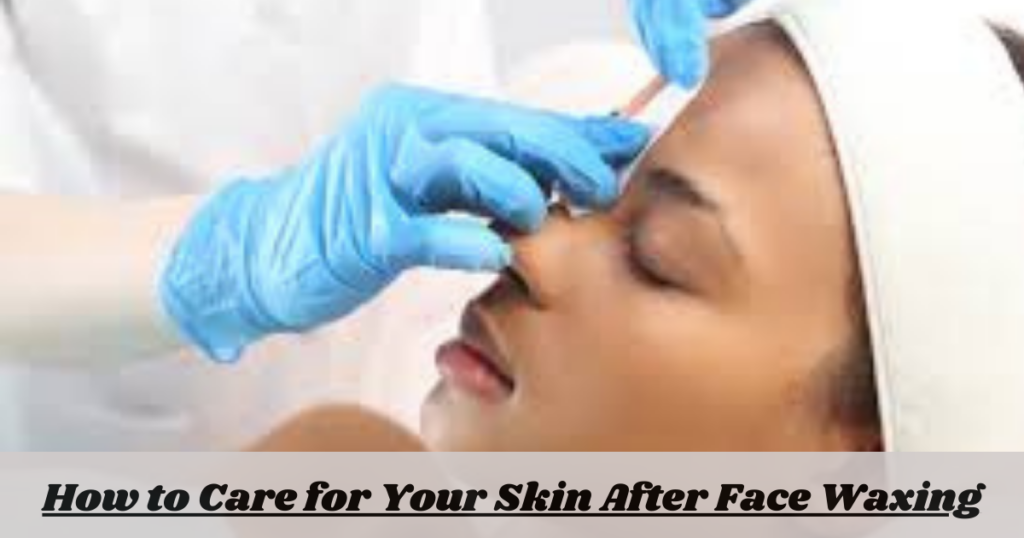Face waxing is a popular hair removal method that offers numerous benefits for achieving smooth and radiant skin. In this guide, we will explore the benefits of face waxing, explain how it is done, and provide detailed instructions on how to care for your skin after face waxing. Whether you are considering trying face waxing or are already a fan, these tips will help you maintain healthy and glowing skin.

How Is Face Waxing Done?
Face waxing is a popular method of hair removal that involves applying warm wax to the facial skin in areas where unwanted hair exists, then swiftly removing the wax along with the hair from the roots. Here’s a step-by-step guide on how face waxing is typically done:
1. Preparation:
Cleanse the Skin: Before waxing, the facial skin is thoroughly cleansed to remove any dirt, oil, or makeup. This ensures better adherence of the wax to the hair and reduces the risk of irritation.
Assess the Hair Length: The hair on the face should ideally be at least a quarter-inch long for effective waxing. If the hair is too short, it may not adhere well to the wax, resulting in incomplete removal.
Patch Test: Perform a patch test on a small area of the skin to check for any adverse reactions or sensitivity to the wax.
2. Heating the Wax:
The esthetician or individual performing the waxing heats the wax to a suitable temperature, typically using a wax warmer or microwave.
It’s essential to ensure that the wax is heated to the appropriate consistency—fluid enough to spread easily but not too hot to cause burns or discomfort.
3. Application of Wax:
Using a spatula or applicator, the warm wax is applied evenly to the desired areas of the face, such as the upper lip, chin, eyebrows, or sides of the face.
The wax is applied in the direction of hair growth, ensuring thorough coverage of the hair to be removed.
4. Placing the Wax Strips:
Once the wax is applied, a wax strip or cloth is pressed firmly onto the waxed area, adhering to the wax and hair.
The esthetician ensures that the strip is smoothed down in the direction of hair growth to maximize adhesion.
5. Removing the Wax:
After allowing the wax to cool and adhere to the hair, the esthetician swiftly removes the wax strip in the opposite direction of hair growth, pulling it taut against the skin.
The removal should be quick and decisive to minimize discomfort and ensure effective hair removal.
Is Face Waxing Worth Trying?
Face waxing is worth trying for those looking for a long-lasting hair removal method with multiple benefits. Here are seven benefits of face waxing:
Smooth and Radiant Skin:
Face waxing removes unwanted hair and exfoliates the skin, revealing a smoother and more vibrant complexion.
Minimized Wrinkles and Fine Lines: The tautness of the skin during waxing can temporarily reduce the appearance of wrinkles and fine lines, leading to a more youthful look.
Refined Pores:
Facial waxing helps minimize the appearance of large and conspicuous pores, resulting in a clearer and healthier complexion.
Reduced Hair Growth:
By removing the hair follicle from the root, face waxing can slow down hair regrowth, leading to finer and sparser hair over time.
Nourished and Protected Skin:
Facial waxing not only removes unwanted hair but also eliminates dead skin cells, allowing new skin cells to emerge and providing a protective barrier against sun damage.
Does Face Waxing Loosen the Skin?
Face waxing does not loosen the skin when performed correctly by a trained professional. However, it is important to follow proper techniques and precautions to minimize any potential risks or side effects. If you have concerns about the impact of face waxing on your skin, consult with a professional esthetician who can provide personalized advice based on your skin type and condition.

How to Care for Your Skin After Face Waxing
1. Post-Waxing Soothing Treatments
Immediately after face waxing, it’s crucial to soothe the skin to alleviate any discomfort and reduce redness. Apply a cooling gel or aloe vera to the waxed area to calm inflammation and hydrate the skin. Look for products specifically formulated for sensitive skin to minimize the risk of irritation.
2. Avoid Sun Exposure
Exposure to sunlight immediately after waxing can exacerbate irritation and increase the risk of pigmentation issues. Shield your skin from the sun’s harmful rays by wearing a broad-spectrum sunscreen with an SPF of 30 or higher. Opt for physical sunscreens containing zinc oxide or titanium dioxide for gentle protection.
3. Gentle Cleansing Routine
Maintain a gentle cleansing routine to keep the waxed area clean without stripping away natural oils. Use a mild, fragrance-free cleanser suitable for sensitive skin, and avoid harsh scrubbing or exfoliation for at least 24 hours post-waxing.
4. Moisturize Regularly
Hydration is key to promoting skin healing and preventing dryness after face waxing. Choose a non-comedogenic moisturizer to replenish lost moisture without clogging pores. Apply moisturizer twice daily, focusing on the waxed area, to maintain soft, supple skin.
5. Avoid Touching or Picking
Resist the urge to touch or pick at the waxed area, as this can introduce bacteria and increase the risk of infection. Keep your hands clean and refrain from scratching or rubbing the skin, allowing it to heal naturally.
6. Skip Harsh Chemicals
Refrain from using products containing harsh chemicals, such as retinoids, alpha hydroxy acids (AHAs), or alcohol-based toners, immediately after face waxing. These ingredients can further irritate the skin and disrupt the healing process.
7. Opt for Loose Clothing
Choose loose-fitting clothing to prevent friction and irritation against the waxed area. Tight clothing can exacerbate inflammation and discomfort, so opt for breathable fabrics like cotton to allow the skin to breathe freely.
8. Avoid Hot Baths or Showers
Hot water can exacerbate post-waxing inflammation and sensitivity, so opt for lukewarm showers or baths instead. Avoid steam rooms, saunas, and hot tubs for at least 24 to 48 hours post-waxing to prevent further irritation.
9. Refrain from Makeup
Give your skin time to breathe and heal by refraining from applying makeup to the waxed area immediately after treatment. If you must wear makeup, choose non-comedogenic, hypoallergenic products and ensure thorough removal at the end of the day.
10. Schedule Regular Exfoliation
Once the initial redness and inflammation have subsided, incorporate gentle exfoliation into your skincare routine to prevent ingrown hairs and maintain smooth, even skin texture. Opt for a mild exfoliating scrub or chemical exfoliant containing salicylic acid or fruit enzymes, and use it 2-3 times per week.
Conclusion
By following these tips, you can ensure a smooth and comfortable face waxing experience. Remember to prioritize gentle, soothing treatments and avoid harsh chemicals or practices that may exacerbate post-waxing sensitivity. With proper care and attention, you can enjoy the benefits of face waxing while preserving the health and integrity of your skin.

